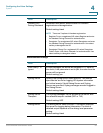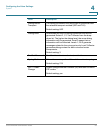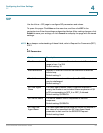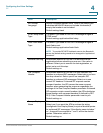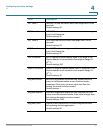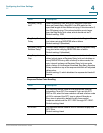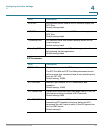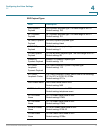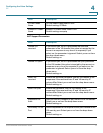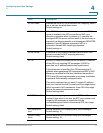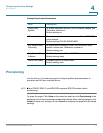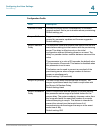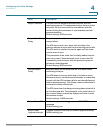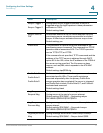
Configuring the Voice Settings
SIP
Cisco SPA232D Administration Guide 70
4
RTCP Tx Interval Interval for sending out RTCP sender reports on an active
connection. It can range from 0 to 255 seconds. During an
active connection, the ATA can be programmed to send
out compound RTCP packet on the connection. Each
compound RTP packet except the last one contains a SR
(Sender Report) and a SDES (Source Description) The last
RTCP packet contains an additional BYE packet. Each SR
except the last one contains exactly 1 RR (Receiver
Report); the last SR carries no RR. The SDES contains
CNAME, NAME, and TOOL identifiers. The CNAME is set to
<User ID>@<Proxy>, NAME is set to <Display Name> (or
Anonymous if user blocks caller ID), and TOOL is set to the
Vendor/Hardware-platform-software-version. The NTP
timestamp used in the SR is a snapshot of the local time
for the ATA, not the time reported by an NTP server. If the
ATA receives a RR from the peer, it attempts to compute
the round trip delay and show it as the Call Round Trip
Delay value (ms) on the Information page.
Default setting: 0
No UDP Checksum Select yes if you want the ATA to calculate the UDP
header checksum for SIP messages. Otherwise, select no.
Default setting: no
Stats In BYE Determines whether the ATA includes the P-RTP-Stat
header or response in a BYE message. The header
contains the RTP statistics of the current call. Select yes or
no from the drop-down list.
Default setting: yes
The format of the P-RTP-Stat header is:
P-RTP-State: PS=<packets sent>,OS=<octets
sent>,PR=<packets received>,OR=<octets
received>,PL=<packets lost>,JI=<jitter in ms>,LA=<delay
in ms>,DU=<call duration
ins>,EN=<encoder>,DE=<decoder>.
Field Description



